Heavy tank Henschel VK 3601 (H), Germany
Unlike its predecessors, the heavy tank VK 3001 (H) had rather high characteristics and was of particular interest to the army. However, it was not without some technical problems, and besides, the customer was not satisfied with the fighting qualities of such a machine. The defense and firepower of the tank were considered insufficient and in need of reinforcement. For this reason, in May 1941, it was decided to start developing new armored vehicles. The first such development was the VK project 3601 (H). A little later, another heavy tank project was launched with further enhanced performance.
The main changes in the technical assignment that distinguished it from previous similar documents concerned the protection and armament of a promising tank. Thus, the thickness of the frontal armor was required to bring to 100 mm. The turret gun was supposed to pierce a similar defense of the enemy tank from a distance of 1500 m. Thus, a gun of at least 75 mm with a relatively long barrel should be used. According to other data, the weapon used was supposed to pierce at least 140 mm of armor with 1000 m, and the task of the armor was to protect the tank from similar threats.
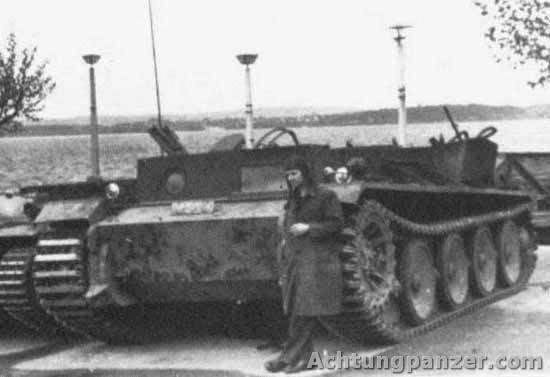
The first prototype chassis VK 3001 (H). Photo by Achtungpanzer.com
Preliminary estimates and analysis of changes in the appearance of technology has shown that the promising heavy tank will be much heavier than its predecessors. Its combat mass was to increase from 30 to 36 t. For this reason, as well as due to the lack of similar developments in the past, the project received the designation VK 3601 (H). The letter in the locks meant a contracting company that was to develop a new armored vehicle.
Updating the requirements for protection and armament entailed the processing of all the main elements of an existing project. Thus, an increase in the thickness of the armor, associated with an increase in the weight of the machine, should be compensated for by strengthening the undercarriage and a more powerful engine. The use of a higher-powered weapon, in turn, required reworking the layout of the combat compartment, as well as changing the design of the hull and turret accordingly. Because of such alterations, the VK 3001 (H) and VK 3601 (H) tanks had some similarities, but they were noticeably different from each other.
Requirements to increase the level of protection led to noticeable alterations in the design of the armored hull. The body retains the frontal part formed by several sheets 60 and 100 mm thick. The top sheet of the forehead has traditionally had openings for the installation of viewing instruments for crew workplaces. The hull also received 60-mm vertical sides and aft 60-80 mm thick. The machine was protected from above and below by sheets 26 mm thick. Such a reservation is fully consistent with the technical requirements and allowed to protect the tank from a significant number of threats.
An armored turret was also developed with a level of protection that matched the hull. Frontal parts of this unit should have a thickness of up to 100 mm, sides and feed - 80 mm. The size of the tower made it possible to accommodate a new type of weapon, which differed from existing developments by other sizes, rollback parameters, etc.
The layout of the case did not change in comparison with the previous development. In front of the case were placed the transmission compartment and the control compartment. Behind them was a fighting compartment with shoulder strap of increased diameter. Feed has traditionally stood out for the installation of the engine and auxiliary systems.
To compensate for the increased combat mass, the prospective tank was to receive an engine of increased power. The Maybach HL 210 gasoline engine with an 655 horsepower capacity should have been placed in the aft hull compartment. The mechanical transmission was retained, in the design of which made some adjustments related to the increase in engine power.
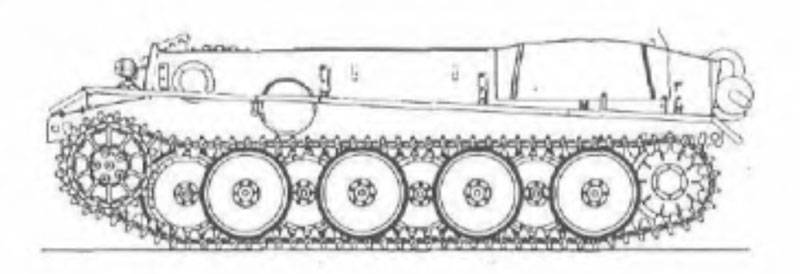
Chassis layout. Figure Baryatinsky MB "Heavy tank" Tigr "" // "Armored collection"
The chassis of the VK 3601 (H) tank was based on the aggregates of the existing VK 3001 (H), however it was strengthened to provide the required performance. On each side of the hull there should have been eight double support rollers of large diameter, equipped with rubber bands. The rollers were equipped with an individual torsion suspension and were staggered. The drive wheels were located in the front of the hull, guides - in the stern. The large diameter of the rollers allowed to abandon the use of support rollers. Under the new project, the appearance of the undercarriage was formed, which was subsequently used with minimal changes in new projects.
A promising heavy tank was supposed to use a new type of gun with enhanced characteristics. The existing tank guns did not fully suit the authors of the project for one reason or another. For example, the 8,8 cm KwK 36 gun had acceptable power, but was too large, and the 7,5 cm KwK 40 gun, while meeting the size requirements, did not show the necessary fighting qualities. Thus, it was proposed to use a completely new weapon that met all the existing requirements for armor penetration and dimensions.
By this time, Krupp had developed an experimental Gerät 0725 gun with a conical bore. In the breech, the barrel of this system had a caliber of 75 mm, in the muzzle - 55 mm. The length of the barrel was 55 calibers. Especially for the gun was developed by a new 55-mm projectile with a collapsing lead belt and a tungsten core. According to the main indicators of fire, the Gerät 0725 gun was comparable to 88-mm tank guns, but it was distinguished by smaller dimensions. Thanks to this, it was possible to do without a serious rearrangement of the combat compartment, as well as significantly increase the tank ammunition in comparison with projectiles of larger caliber.
A promising instrument of variable caliber was to be located in a rotating turret on a rocking installation. With the help of hydraulic drives should be provided horizontal guidance weapons in any direction and vertical within a small sector. For pointing the gun should use a telescopic sight with the required parameters.
The auxiliary weapon of the advanced heavy tank was to consist of two MG 34 machine guns of 7,92 mm caliber. One machine gun should be mounted on a gun mount, the second - in the embrasure of the front hull sheet. The use of anti-aircraft machine guns or other weapons was not intended.
It was planned to introduce five people into the crew: a driver, a radio operator, a gunner, a commander and a loader. The first two were located in the front of the case, in the control compartment. The driver's seat was placed at the left side and equipped with a viewing hatch in the front hull plate. The radio operator was located to his right. In the front sheet in place of the radio operator there was an installation for a machine gun. In addition, the workplace of this crew member was supposed to be equipped with a radio station FuG 5. Management Department received two hatches in the roof, with which tankers had to fall into place.
VK project 3601 (H) provided for the use of a three-seat tower, which housed the gunner, commander and loader. They had a set of viewing instruments in the roof of the tower, and also had in their places a set of all the necessary controls. Due to the increased defense of the tower to the required performance, all hatches for access inside the fighting compartment were placed on the roof of the tower. Side hatches, as in some older projects, were absent.
The total length of the advanced heavy tank slightly exceeded 5,8 m, the width was 3,16 m, height (on the roof of the hull) - 1,85 m. Despite the use of thicker armor and other innovations, the combat weight of the machine had to comply with the technical task. The weight of the chassis was 31,5 tons.
VK 3601 (H) project was a significantly modified version of the existing VK 3001 (H), which had a positive impact on the timing of the work. The development of a new heavy tank took only a few weeks, after which the opportunity arose to build a wooden demo of the new machine. This product was presented to the customer 25 May 1941. The layout and documentation of the project were shown to representatives of the army, who gave the go-ahead to continue the work. At the same time, the project required some adjustments. Upon completion of these works, several prototypes of the new technology should be built and then tested.
In the late spring of 1941, the prospects for a new project were also identified. According to the plans of that time, in the foreseeable future it was necessary to build and test new type of experimental machines, and then to start mass production of such equipment. By this time, the heavy tank VK 3601 (H) was no longer considered as a full-fledged means of re-equipping armored forces. Now he was considered a way to prepare the army for the operation of new technology. It was planned to build an entire 172 serial tank of this type, which should have been sent to various units. A heavy tank of the next model, which was planned to be created on the basis of VK 3601 (H), was to go to a full-fledged and large-scale mass production.
Construction of an experienced VK 3601 (H) chassis began at the end of 1941 and continued until the first months of 42. During the assembly of the prototype, Henschel had to face some problems that resulted in the finalization of the project. So, due to the lack of the required 655-strong engine, an less powerful Maybach HL 174 engine, which produced only 450 hp, had to be installed on an experienced armored vehicle. Transmission remained unchanged.
Also, there were problems with the tower and weapons, which in the end were not installed on an experienced chassis. The main difficulties were associated with a promising tool Gerät 0725. This gun was supposed to use the original shells with a tungsten core mass 1 kg. Simple calculations rather quickly showed that the mass production of such ammunition would lead to the complete exhaustion of the existing reserves of scarce tungsten, striking the production of a number of necessary products. In addition, the conical barrel was too expensive, and also did not have a high resource. Such features of the new cannon led to the fact that it was no longer regarded as a real weapon for promising armored vehicles. Earlier, Gerät 0725 was considered a very successful and promising development, but by the beginning of 1942, plans for its production had been abandoned.
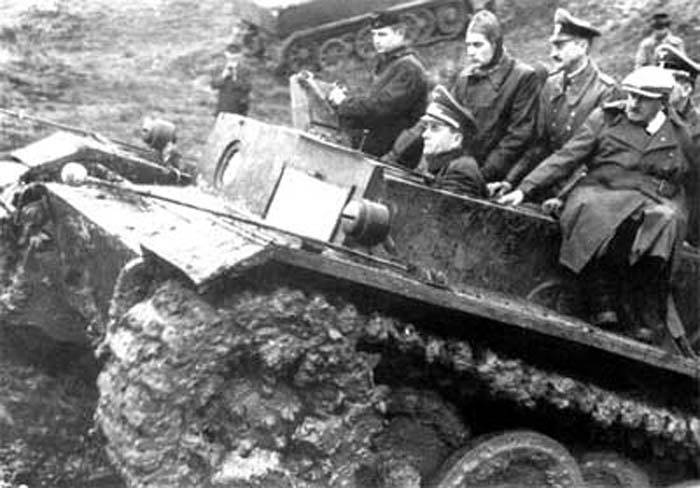
Overcoming obstacles. Photo Aviarmor.net
The rejection of the use of a gun with a tapered barrel forced the designers of the company Henschel to begin the search for new weapons for a heavy tank. Again, research was conducted on the use of existing and future tank guns caliber 75 and 88 mm. In addition, according to some data, even the version of the tower with an 105 mm caliber gun was considered. Nevertheless, the choice of a new gun required, at a minimum, the processing of the existing turret or even the design of a new such unit. As a result, the creation of a new combat compartment required additional time wasting, which should have led to a serious delay in all the work on the heavy tank.
It should be noted that by the time the decision to abandon the Gerät 0725 cannon was made, the factories involved in the VK 3601 (H) project had created a reserve for the production of the required towers. During the construction of the experimental equipment, the German industry managed to assemble several "hubcaps" for a promising gun, the fate of which was in doubt.
The first prototype of the heavy tank chassis was tested at the start of the 1942 of the year. By this time, work on the new turret with high-grade armament had not yet been completed, due to which only the chassis without a combat compartment went to the landfill. It is noteworthy that, unlike some previous chassis, the VK 3601 (H) prototype did not receive even the weight of the tower imitator in the form of a load of the corresponding mass. The car moved around the site with an open shoulder strap tower and without any objects on the roof.
The prototype of a promising tank, the first to be tested, was equipped with a non-standard engine of lower power. This led to a drop in power density from the calculated 18,2 to the 14,3 hp. per ton with corresponding consequences for the mobility of the armored vehicle. Due to insufficient engine power, the prototype chassis could reach speeds of no more than 40 km / h on a good road. Such indicators were sufficient, but after installing the turret with weapons, the tank still needed a more powerful engine, able to compensate for a noticeable increase in the weight of the structure in comparison with previous projects.
The VK 3601 (H) project started in May 1941. A few days after that, the development of another variant of a promising heavy tank began. This time it was necessary to once again improve the basic characteristics of the armored vehicle due to certain innovations, which should have led to an increase in the combat mass to 45 T. As a result, the new project developed by Henschel received the symbol VK 4501 (H). The prototype of this machine was supposed to be tested no later than April 1942 of the year. Over the next few months, work on the 36 and 45 t tanks was carried out in parallel.
In the course of the VK project, 4501 (H) it was decided to dispense with bold proposals relating to certain technical features. For example, the possibility of using a gun with a conical bore was no longer considered: the tank had to carry one of the existing guns. This made it possible to complete all the design work on time, and in the spring of 42 to submit a prototype of a promising heavy tank for testing. Ground tests of the VK 3601 (H) and experienced VK 4501 (H) chassis started almost simultaneously.
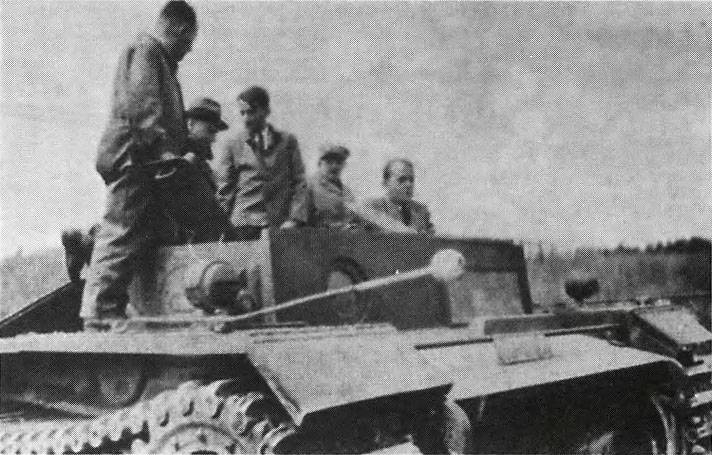
Experienced car at the site. Photo of Chamberlain P., Doyle H. "Complete reference book of German tanks and self-propelled guns of the Second World War"
During inspections it was found that a tank of greater mass has certain advantages over its predecessor. There was superiority in basic characteristics, and in addition, he could get the required weapons without any significant difficulties. As the two samples were tested, the military was increasingly inclined to a new project, which could negatively affect the future of slightly older VK 3601 (H).
According to the results of the first tests of two prototypes, it was decided to further develop heavy tanks. Sample VK 3601 (H) was considered unpromising due to a number of characteristic shortcomings. One of the main reasons for abandoning this project was the lack of a ready-made tower with new weapons, the development of which was seriously delayed. Further development was to receive an alternative armored vehicle project with a greater combat mass. By the end of spring 1942, Henschel focused all its efforts on heavy tanks on the VK 4501 (H) project. The development of the second machine was discontinued.
By the time of completion of the work in the framework of the VK 3601 (H) project, several experimental machines and units were built for them. The tests planned to release six chassis, similar to the first prototype. In addition, they could become carriers of six towers, which still needed to be improved. Due to the closure of the project, the towers were not mounted on the chassis and were not equipped with new weapons. Subsequently, the fate of the constructed units was determined: the decision of the military and the developers of finished products was planned to be used separately from each other for different purposes.
Armored tracked chassis, which were supposed to be experienced tanks, decided to rebuild the updated project. They installed winches, cable feeding systems and other equipment that allowed solving auxiliary tasks. After this upgrade, the six VK 3601 (H) chassis became armored repair and recovery vehicles. The exact fate of such a technique is unknown. Perhaps she was sent to the front to work with damaged tanks of combat units. Apparently, all six cars were eventually destroyed by the enemy. None of these cars survived until the end of the war.
Towers for experienced tanks were armed with existing types, after which they were sent to Western Europe. The use of these products for their intended purpose was no longer planned, but the armored units nevertheless decided to use in the interests of the army. Fighting units without a chassis were mounted on various fortifications of the Atlantic Wall. Details of the combat use of such towers are unknown.
The first prototype of the promising tank chassis was returned to the manufacturer after participation in the tests. According to various sources, the armored vehicle had been idle for a long time in the factory. There is unconfirmed information according to which the VK prototype VK 3601 (H) at the end of the war was captured by the allies, after which it became the subject of study. The machine was not of particular interest, because of which, soon after the war was over, it was utilized.
The project of the heavy tank VK 3601 (H) was created as an improved version of the existing machine VK 3001 (H) with enhanced characteristics. Soon after the start of work, it was decided to make this armored vehicle an auxiliary development, which was to create a reserve in a new direction, but at the same time be built in relatively small quantities. In the future, the authors of the project were faced with serious problems that led to delays in the work and failure to meet the requirements of the technical specifications. At the same time, significant success was achieved in the framework of the VK 4501 (H) project. This situation led to the abandonment of one of the projects in favor of another. The project of the heavy tank VK 3601 (H) was completed with the construction of only a few experienced chassis and towers, which is not a success. However, this project allowed the developer to get the necessary experience, which was used during the creation of the next project. The result of the VK 4501 (H) project was the appearance of the first serial heavy tank of Nazi Germany - Pz.Kpfw.VI Tiger.
Based on:
http://achtungpanzer.com/
http://aviarmor.net/
http://tanki-tiger.narod.ru/
Chamberlain P., Doyle H. Complete reference book of German tanks and self-propelled guns of the Second World War. - M .: AST: Astrel, 2008.
Baryatinsky M.B. Heavy tank "Tigr" // Armored collection. 1998. No.6.
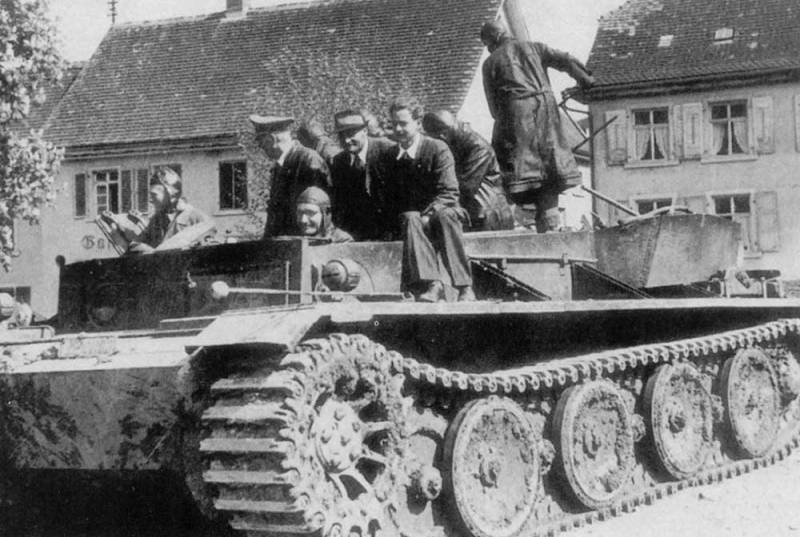
Information